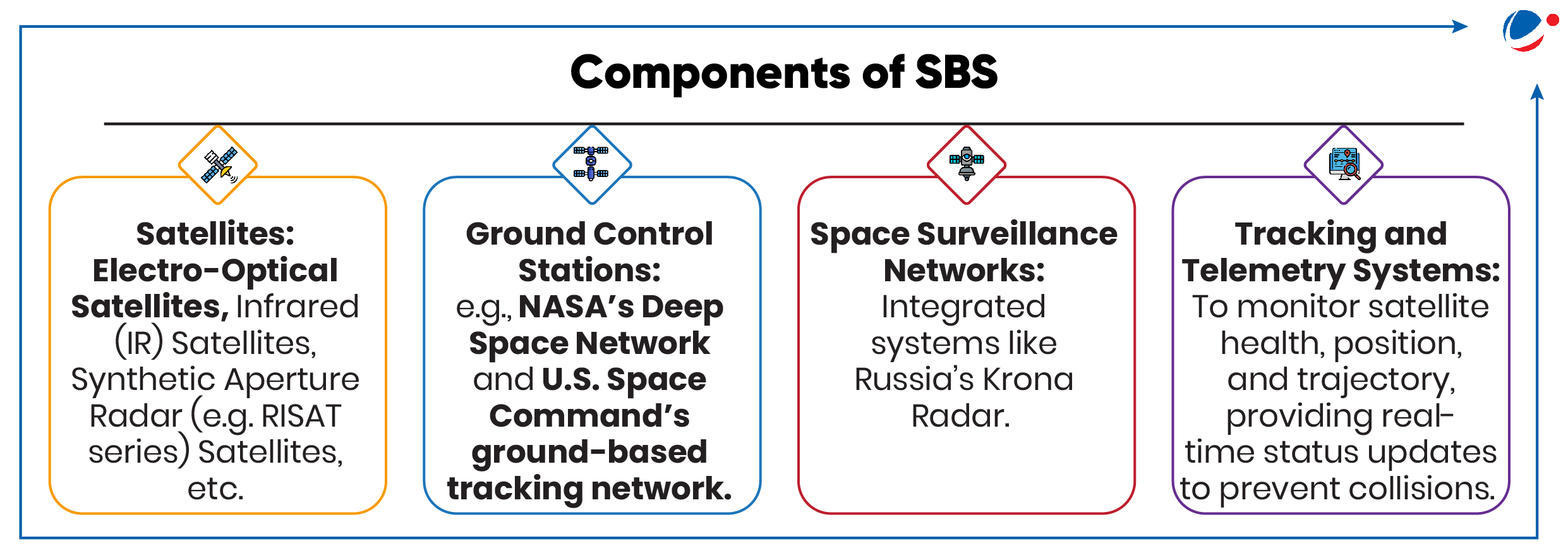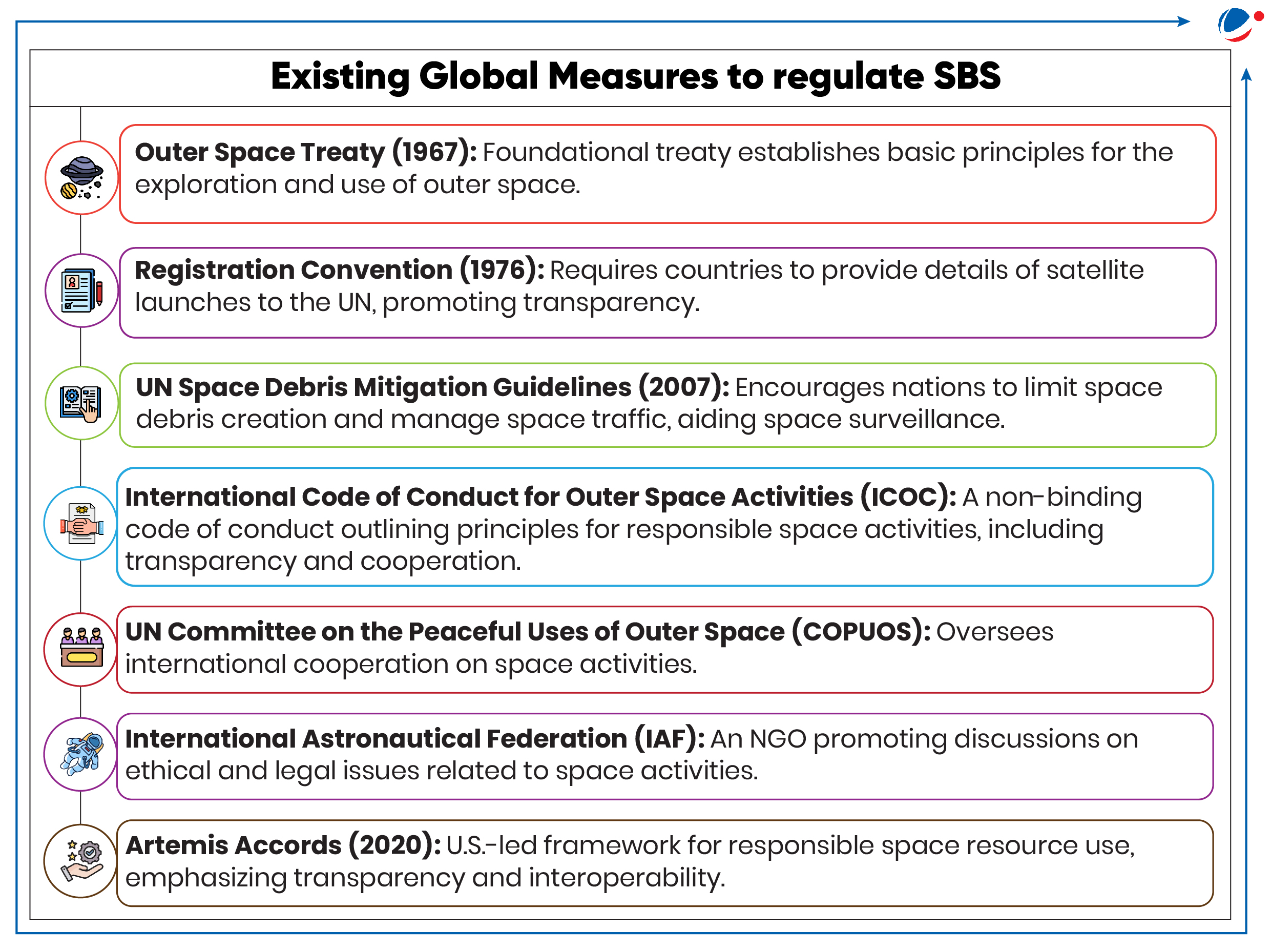Why in the News?
Recently, Cabinet Committee on Security (CCS) has approved the third phase of the Space-based Surveillance (SBS-3) project for better land and maritime domain awareness for civilian and military applications.
More on the News
- SBS-3 includes 52 satellites in Low Earth Orbit (LEO) and Geostationary Orbit (GEO) for surveillance.
- The new fleet of satellites will be at different orbits based on artificial intelligence (AI) and will be able to "interact with each other in space to gather geo-intelligence" on the Earth.
- When a satellite in GEO (36,000 km) detects something, it can request a closer look from a satellite in LEO (400–600 km), providing more detailed information.
- Earlier, Union Cabinet also gave clearance to purchase 31 weaponised Predator drones from US-based General Atomics to enhance surveillance capability of the SBS-3 mission.
India's SBS Projects | ||
SBS-1 (approved in 2001) | SBS-2 (approved in 2013) | SBS-3 |
Focused on basic surveillance capabilities. | Focused on enhanced surveillance capabilities, particularly for maritime domain awareness. | Proposes to utilize both LEO and GEO satellites for comprehensive coverage. |
Involved launch of 4 surveillance satellites - Cartosat-2A, Cartosat-2B, RISAT-2, and Eros-B | Involved the launch of 6 additional surveillance satellites - Cartosat-2C, Cartosat-2D, Microsat-1, RISAT-2A etc. | Three services will have dedicated satellites for their land, sea, and air based missions. |
About Space-based Surveillance (SBS)

- It involves the use of satellites and other space assets to monitor and collect data on objects and activities in space and on Earth.
- SBS systems are used primarily for national security, space situational awareness, environmental monitoring, and data gathering for scientific research.
- Major spacefaring nations, including the U.S., Russia, China, and India, are actively investing in SBS for national security.
- The U.S. has the most extensive network, including systems like the Space-Based Infrared System (SBIRS) and the upcoming Next-Generation Overhead Persistent Infrared (Next-Gen OPIR) satellites for missile detection and surveillance.
Significance of Space-based Surveillance (SBS)
- National Security and Defence: Detecting, tracking, and monitoring potential threats, such as missile launches, military activities, and unauthorized satellite manoeuvres.
- e.g., India's EMISAT satellite provides electronic intelligence by intercepting signals.
- Space traffic management and collision avoidance: ISRO's NETRA (Network for Space Object Tracking and Analysis) initiative aims to track space debris and provide space situational awareness to safeguard India's space assets.
- Protection of Space assets: India conducted its Mission Shakti ASAT test in 2019, showcasing its ability to protect and defend its space assets, while also emphasizing the need for surveillance to monitor space-based threats.
- Environmental monitoring and disaster response: SBS is crucial for real-time monitoring of natural disasters, climate change, and environmental changes like deforestation, glacier melt, and ocean health.
- e.g., Cartosat satellites used by India.
- Scientific research and data collection: SBS allows for the collection of data on cosmic phenomena (like solar flares, asteroids, and space weather) and Earth observations.
Concerns with Space-based Surveillance (SBS)

- Dual-use Technology: Space surveillance technologies can be used for both peaceful and military purposes due to ambiguities in intentions, difficulties in verification of regulatory compliances, etc.
- Potential for Militarization and arms race in Space: Increased military interest in space raised concern of an arms race as nations compete to secure strategic advantages in space.
- e.g., The U.S. established the Space Force in 2019, and Russia formed the Aerospace Forces in 2015, both aimed at enhancing military capabilities in space.
- Violations of privacy: High-resolution satellites can potentially monitor ground-level activities, raising concerns about individual privacy and national security.
- Legal and Regulatory Gaps: Foundational treaties like Outer space Treaty (1967) which mandates that space should be used for peaceful purposes, lacks specific language addressing surveillance and other modern military uses of space.
- International Tensions: Unauthorized surveillance can heighten diplomatic tensions and lead to accusations of espionage.
- e.g., In 2023, a Chinese surveillance balloon detected over U.S. territory led to diplomatic strain, illustrating the risks of international surveillance conflicts.
- Space Debris and Collisions: More satellites in crowded orbits, increasing the risk of collision with space debris or other operational satellites.
Conclusion
Space-based surveillance stands as a powerful tool with the potential to transform our understanding of the planet, enhance disaster response, and foster scientific collaboration. As we advance into an era of increasing reliance on satellite technology, it is crucial for the global community to create transparent and fair frameworks that prevent misuse, encourage responsible innovation, and ensure that space remains a domain for shared progress and stability.





